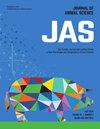Influence of Biochar supplementation on comparative growth-performance and carcass characteristics of Angus x Holstein vs Charolais x Holstein calf-fed steers
IF 2.7
2区 农林科学
Q1 AGRICULTURE, DAIRY & ANIMAL SCIENCE
引用次数: 0
Abstract
The objective of the current study was to was to determine the influence of biochar supplementation on steer growth performance, carcass characteristics, and ruminal temperature of calf-fed Angus × Holstein (AXH) crossbred steers versus calf-fed Charolais × Holstein (CXH) crossbred steers fed for over 300 days. Fifty-six AXH crossbred steers (body weight (BW) = 192 ± 12 kg), and 56 CHX steers (BW = 188 ± 13 kg) were blocked by initial BW and assigned randomly to 28 pens. Dietary treatments consisted of a steam-flaked corn-based diet supplemented with 1) no biochar supplementation (control); 2) 0.2% (dry matter (DM) basis) of Biochar. Data were analyzed as a randomized complete block in a 2 x 2 factorial arrangement, using pens as experimental unit. From 112 to 224 days on feed, dietary supplemental biochar decreased (P = 0.05) cattle average daily gain (ADG). However, there were no other dietary effects (P ≥ 0.11) on steer growth performance or performance-adjusted net energy values. Biochar supplementation tended (P ≥ 0.08) to decrease marbling score and increase calf morbidity. Biochar had no other effects (P > 0.13) on carcass characteristics. Angus cross steers had a greater (P ≤ 0.05) final live weight and dry matter intake compared to CXH steers. Moreover, AXH steers tended (P = 0.09) to have overall ADG, and had a 9.4% greater (P = 0.03) overall ADG in the last 78 days compared to CXH. There were no differences (P ≥ 0.44) between breeds for gain efficiency or net energy for maintenance or gain based on growth performance. Charolais cross steers had the lesser (P ≤ 0.04) average ruminal temperature during the months of June, July, August, and November, while there were no ruminal temperature differences in September and October (P > 0.10). Angus cross steers demonstrated an increase (P ≤ 0.04) in kidney, pelvic, and heart fat, backfat thickness, marbling, and yield grade compared to CXH; however, CXH had a larger (P = 0.01) longissimus muscle area. There were no other differences (P ≥ 0.11) in carcass characteristics, health, or liver abscesses between breeds. Results indicate that biochar supplementation at 0.20% (DM basis) did not affect growth performance or carcass characteristics; however, breed (Angus vs. Charolais) used in a beef on dairy cross did affect carcass characteristics, including carcass weight, and muscle and fat deposition; showing the importance of proper breed selection when a beef on dairy crosses production.添加生物炭对安格斯×荷斯坦与夏洛莱×荷斯坦犊牛比较生长性能和胴体特性的影响
本研究的目的是确定生物炭添加对犊牛安格斯×荷斯坦(AXH)和夏来×荷斯坦(CXH)杂交犊牛饲喂300 d以上的生长性能、胴体特性和瘤胃温度的影响。56头AXH杂交阉牛(体重(BW) = 192±12 kg)和56头CHX杂交阉牛(BW = 188±13 kg)按初始体重进行封闭,随机分配到28个栏中。饲粮处理包括:1)不添加生物炭(对照组);2) 0.2%(干物质(DM)基础)的生物炭。以笔为实验单位,以2 × 2因子排列的随机完整块分析数据。在饲喂112 ~ 224 d期间,饲粮中添加生物炭降低了牛的平均日增重(P = 0.05)。然而,饲粮对肉牛生长性能和性能调整净能值没有其他影响(P≥0.11)。添加生物炭有降低大理石纹评分和增加小牛发病率的趋势(P≥0.08)。生物炭没有其他影响(P >;0.13)胴体特性。安格斯杂交肉牛的末活重和干物质采食量均高于CXH肉牛(P≤0.05)。此外,与CXH相比,AXH的肉牛在最后78天的总ADG增加了9.4% (P = 0.03),总体ADG倾向于(P = 0.09)。不同品种之间的增重效率、维持能和基于生长性能的增重净能均无差异(P≥0.44)。夏来杂交肉牛在6、7、8、11月份的平均瘤胃温度较低(P≤0.04),9、10月份的瘤胃温度无显著差异(P > P < 0.05);0.10)。与CXH相比,安格斯杂交肉牛肾脏、骨盆和心脏脂肪、背脂肪厚度、大理石纹和产量等级均增加(P≤0.04);而CXH组最长肌面积较大(P = 0.01)。在胴体特征、健康状况或肝脓肿方面,品种间无其他差异(P≥0.11)。结果表明,添加0.20% (DM)的生物炭不影响生长性能和胴体特性;然而,在奶牛杂交中使用的品种(安格斯与夏洛莱)确实影响了胴体特性,包括胴体重量、肌肉和脂肪沉积;显示了正确的品种选择的重要性,当奶牛牛肉交叉生产。
本文章由计算机程序翻译,如有差异,请以英文原文为准。
求助全文
约1分钟内获得全文
求助全文
来源期刊

Journal of animal science
农林科学-奶制品与动物科学
CiteScore
4.80
自引率
12.10%
发文量
1589
审稿时长
3 months
期刊介绍:
The Journal of Animal Science (JAS) is the premier journal for animal science and serves as the leading source of new knowledge and perspective in this area. JAS publishes more than 500 fully reviewed research articles, invited reviews, technical notes, and letters to the editor each year.
Articles published in JAS encompass a broad range of research topics in animal production and fundamental aspects of genetics, nutrition, physiology, and preparation and utilization of animal products. Articles typically report research with beef cattle, companion animals, goats, horses, pigs, and sheep; however, studies involving other farm animals, aquatic and wildlife species, and laboratory animal species that address fundamental questions related to livestock and companion animal biology will be considered for publication.
 求助内容:
求助内容: 应助结果提醒方式:
应助结果提醒方式:


